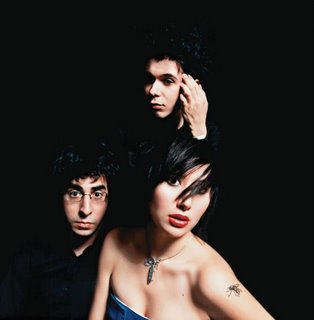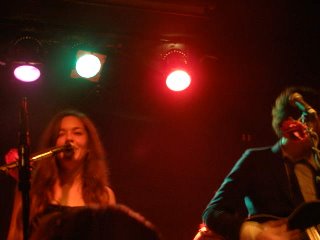
Once in a while, the American musical landscape gets an injection of new life from outside the country’s borders.
Most famously the British Invasion of the 1960s, led by the Beatles and the Rolling Stones, had such an immense impact on American popular culture that over the course of forty years the music of the past still resonates in the music of today.
In 2002, rock music, thought to be dead and stale since the demise of Nirvana in 1994, exploded once again, bringing down the pop groups that saturated much of American radio. This time around it was the land of Sweden coming to the rescue. These bands somehow found what American rock bands couldn’t seem to find or quite sustain—passion. The band that lit the match with its single “Hate To Say I Told You So” was the Hives. Suddenly other Swedish acts, veterans in their home country, were sharing the spotlight like they just formed a week ago, bands such as the Soundtrack of Our Lives and the Hellacopters.
Among those Swedish groups was the dance infused rock band the Sounds, who made their U.S. debut with 2003’s
Living In America. Propelled by the hooky “Seven Days A Week,” the 5-piece band from Helsingborg became a hot buzz band whose energetic live shows worked concertgoers into a hot, sensuous sweat like they had just experienced the raunchiest sex they’ve ever had.
With the band’s sophomore album
Dying to Say This to You now released, the Sounds have embarked on their latest tour of America. In an interview with bassist Johan Bengtsson prior to the band’s U.S. tour, the 26-year-old musician discussed the evolution of the band’s new album, his musical calling as a youth, and the push towards the decade mark for the Sounds.
Chris Castaneda: How was it recording
Dying to Say This to You after the time off since releasing and touring behind the debut album,
Living In America?
Johan Bengtsson: The album was easier to make than I thought it would be. We didn’t write on tour. The time gap between the first album and this album has been quite long. When we got off tour we were like, “Can we really write again?” since we hadn’t written any songs in a long time. But when we actually started to write, the process was pretty quick.
It wasn’t two years, really. We did the Warped Tour and then we turned down a lot of offers. We could have kept on touring but we had to stop it somewhere so we could go back and write a new album. So, after the Warped Tour, we took maybe two, three months off and then started writing. By the summer, we recorded it.
CC: Did Jeff Saltzman’s work on the Killers’ debut album
Hot Fuss capture the band’s attention when it came time to start working on a new album?
JB: It was definitely the album. When we started talking about him, I didn’t know he produced the Killers’ album. We flew over in March and had meetings with different producers. We didn’t meet him at the time, but we heard he was really interested. He said stuff like, “I’d drop everything to work with you guys,” and, “I’d cancel all my projects just to make this album with you guys.” That was appealing to us. Then we got the good deal and he said, “Come up to my studio. We can work as long as you want.”
Recording in America rather than Sweden was something we wanted to do for this album. It was more Jeff choosing us than us begging him to make our album.
CC: What was the recording process like this time around?
JB: We had almost unlimited time whereas the first album we did in maybe two weeks. We didn’t have any experience of being in the studio prior to the first album. This time we had time in the studio to actually work with Saltzman and the songs to make them even better songs.
It’s a really good sounding album, and I think he’s a big part of it. Not only is he a good producer, he’s a good engineer, too.
CC: On
Living In America, each song was running on all engines. There’s a song on
Dying to Say This to You that really goes in a different direction from the first album formula, the slow tempo song “Night After Night.” In fact, there are two versions on the album. As a bonus, you’ve included a faster tempo version of the song. How did that song develop originally?
JB: The fast version was the original version. It was in the studio and Saltzman was saying, “I think this album needs a slower song.” And we were like, “We can’t write slow songs.” We have no idea. He said, “No guys, seriously, you need to write a slow song and this album will be great.”
We couldn’t come up with anything. We just tried and tried. Then late one night we were in the control room and Jesper (Anderberg) was playing the piano. Jeff (Saltzman) was like, “What’s that?” I said, “It’s that other song we’re working on.” Jeff said, “Ok, we got to record it, we got to record it!”
We recorded the piano and then add stuff after that like the drums. We recorded kind of backwards. It turned out really great; it still gives me the chills.
CC: Has the band performed the song live yet?
JB: We only played it once. The first time we ever played any new songs live we did it in our hometown in Sweden. We haven’t played it since then, but we’re planning on playing it as soon as the album comes out.
CC: The Sounds have been together for about eight years, just around the corner from that ten-year mark…
JB: I know. It’s kind of scary [Laughs]. We’ve all been in bands prior to this band, but since day one when we all got together in the rehearsal space there was some weird chemistry between us. Everyone felt, “We don’t have a single song, but I know this is the band that’s gonna make it.”
I think that’s the essential key to having good bands stay together. We’re all a bit different now than we were a few years ago. We’re all getting older; we’re growing older together. We respect each other in a whole other way now. We’re entitled to have private lives that we didn’t have before. I have a kid, a 4-year-old son, and I need time to spend time with my kid; people realize that now.
CC: I noticed James Iha, formerly of the Smashing Pumpkins, had a hand in the album. What was that like?
JB: He and Adam Schlesinger of Fountains of Wayne were in for two sessions; one in the beginning and one in the end. They really helped out a lot. We’ve known James for a few years now; I respect him as a musician. Adam is a great songwriter. It’s good to have those older people who’ve been around for a while and have been in successful bands with us in the studio to ask them for advice.
CC: What inspired you to become a musician or be in a band?
JB: I started playing acoustic guitar when I was a little kid. I found a guitar in the attic of my parents’ house, and I’ve been playing since. I’ve been playing in bands since I was 12.
CC: Was there any particular band that really hit you the hardest that drew you into music more?
JB: I’ve listened to all kinds of music; it’s gone through phases. At one point, I was listening to Metallica a lot as a kid; on the other hand I was listening to Nirvana and the whole Seattle scene when that was going on. I was in seventh grade and playing in bands listening to Nirvana.
CC: See, I was in class doing homework while you were in bands, and you’re just a year ahead of me [Laughs]. So, what memories do you have from your 2003 show at Metro?
JB: We’re good friends with another band from Chicago—Kill Hannah. They opened up for us when we did the headline tour for the first album at Metro. Chicago has always been nice to us; Metro is a really good venue. We like playing there.
CC: Do you have any favorite songs on
Dying to Say This to You?
JB: I really like “Tony the Beat.” It’s a really good pop song with a more experimental vibe to it.
CC: Now, the band shares the songwriting duties in what seems to be a pretty democratic way. Is it pretty fair to say that any idea that gets brought to the table gets a chance to grow?
JB: Actually, that’s exactly how it works. The process was different on this album, though. The first album was written over a long period of time before we even knew we would release an album. We kept on writing songs and kept on trying to get a record deal while playing live as much as possible. All those songs from the first album were played tons of times live before we even recorded them.
On this album, we didn’t have the time to just write forever. So, we built our own studio, a small area where we write. Everything is pretty much written in that studio in Sweden before we take it to the rehearsal place and play it together as a band. So, the process has been different in that way. It gives us time to analyze it more. The songwriting is better now than it was on the first album because it’s more thought through.
 Attitude and swagger are two ingredients to a good rock ‘n’ roll band. Relying on just those two elements isn’t enough to survive on unless there are engaging songs to back up the talk.
Attitude and swagger are two ingredients to a good rock ‘n’ roll band. Relying on just those two elements isn’t enough to survive on unless there are engaging songs to back up the talk. opened the night with furious enthusiasm. Ivarsson showed no fear as she dove into the crowd during “Living In America.” The band kept the show’s pace on high with each song and gave no indication of slowing down. This was evident when the band performed “Night After Night” from Dying to Say This to You. On record, the song appears as two versions: the first as a slow, piano driven take and the other as an up-tempo hidden bonus track. The band opted to perform the “rock” version of the song instead. Proving there was still plenty of kick to their older songs, the Sounds shook up matters even more with vibrant renditions of “Seven Days A Week” and “Hope You’re Happy Now.”
opened the night with furious enthusiasm. Ivarsson showed no fear as she dove into the crowd during “Living In America.” The band kept the show’s pace on high with each song and gave no indication of slowing down. This was evident when the band performed “Night After Night” from Dying to Say This to You. On record, the song appears as two versions: the first as a slow, piano driven take and the other as an up-tempo hidden bonus track. The band opted to perform the “rock” version of the song instead. Proving there was still plenty of kick to their older songs, the Sounds shook up matters even more with vibrant renditions of “Seven Days A Week” and “Hope You’re Happy Now.”






